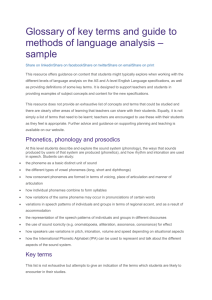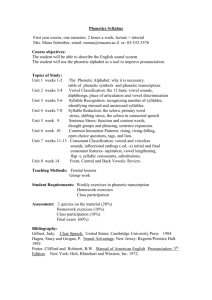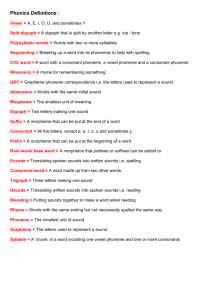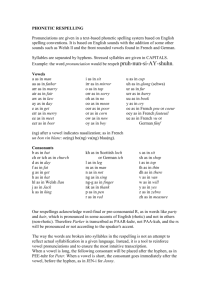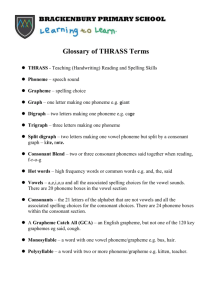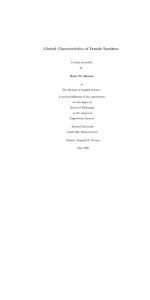Phonetic Terminology
advertisement
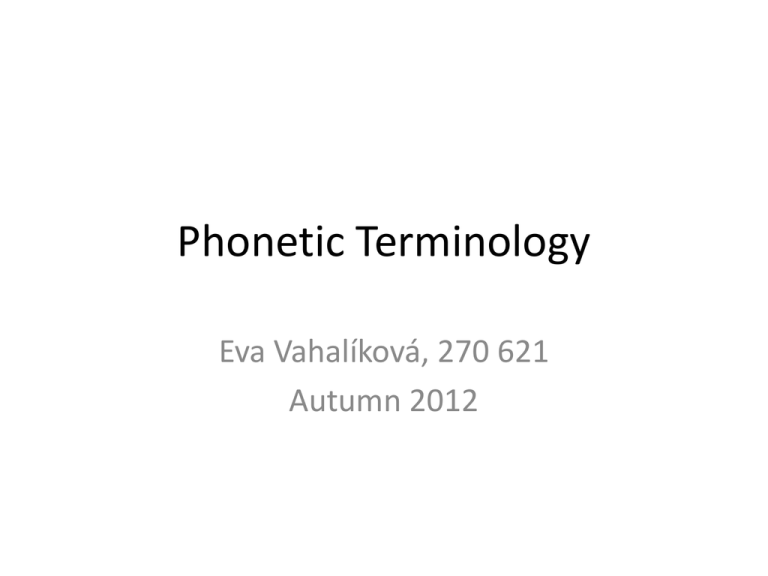
Phonetic Terminology Eva Vahalíková, 270 621 Autumn 2012 Place and manner of articulation What happens whenever you pronounce /b/ or /p/? What do your lips do? On Hall‘s website, you can experiment with the place and the manner of articulation. http://homes.chass.utoronto.ca/~danhall/phon etics/sammy.html Phonetic Chart Do you want to hear individual sounds? Do you wonder what exactly happens to your tongue when pronouncing diph- and triphthongs? And what happens to a Brit‘s or American‘s tongue? Everything clearly listed on Paul Meier‘s webpage: http://www.paulmeier.com/ipa/charts.html Pronunciation Dictionaries Interested in pronunciation only? http://www.howjsay.com/index.php? Macmillan Dict http://www.macmillandictionary.com Cambridge http://dictionary.cambridge.org/help/phoneti cs.html Typing • Do you need to type in IPA? A practical help to be found at http://ipa.typeit.org/full/ phone phoneme /fəʊn/ /fəʊni:m/ an actual speech sound, without regard to the phonology of a language as revealed by phonetic analysis. Note that the /t/ in tab is aspirated in English [th], while in stab it is not [t]; and that the /t/ in little and try are also somewhat differently sounded. Phones that are variants of the same phoneme are called allophones of that phoneme. the smallest single segment of speech capable of distinguishing meaning. Unlike a phone (an actual speech sound), a phoneme is simply the "idea of a sound", its actual realization taking many forms, resulting in different phones. /t/ and /d/ are examples of phonemes, since they contrast sufficiently in minimal pairs, such as bid/bit to change the meaning. accent reduction /'æksənt/ term often used to describe the process of modifying a nonprestige dialect or accent, or changing a foreign-language accent toward a perceived standard mainstream, or prestige dialect allophone /'æləˌfəʊn/ a contextually modified variant of a phoneme. Notice, for example, how the /t/ in team varies from that in try. These are said to be allophones of the phoneme /t/. aspiration assimilation /ˌæspɪˈreɪʃ(ə)n/ /əˌsɪmɪˈleɪʃ(ə)n/ breath; often used to denote the little puff of air that accompanies the release of the voiceless plosives [p, t, k] in most English dialects denoting the fusion of two consonants into one what you want /wɒtʃu: 'wɒnt/ in case you need it /iŋ keiʃu: 'ni:d ɪt/ Has your letter come? /hæʒɔ: 'letə kʌm/ as yet /ə'ʒet/ glottal /ˈɡlɒt(ə)l/ a sound articulated by the vocal folds themselves. The most famous glottal consonant is the glottal stop [ʔ], such as we hear in the classic Cockney butter [bʌʔə], or that we sometimes intrude between two words such as my eye where the second begins with a vowel. glottal reinforcement /ˈɡlɒt(ə)l ˌriːɪnˈfɔː(r)smənt/ term often meaning the coarticulation of the glottal stop with another consonant, usually a stop. One hears this in Newcastle speech, for example, on the /t/ in fourteen: /fɔt͡ʔin/. Frequently this also can be observed in unreleased stops at the end of an utterance, as in stop! [stɒʔp]. co-articulation /kəʊˌɑː(r)ˌtɪkjʊˈleɪʃ(ə)n/ referring to simultaneous articulation of two phonemes /t/+/s/ in tsunami code switching /kəʊd swɪtʃɪŋ/ referring to the practice of varying the style of one's speech according to its purpose or social context; e.g. formal address vs casual speech consonant vowel /ˈkɒnsənənt/ /ˈvaʊəl/ a sound characterized by constriction or closure at one or more points of the speech tract speech sound characterized by total absence of obstruction to the airflow. It is usually the dominant and central part of the syllable. consonant clusters eg. /sps/, /cts/, /sts/ continuant drawl /kənˈtɪnjʊənt/ /drɔːl/ referring to a consonant that may be prolonged indefinitely rather than having the finite duration of a stop /v/, /m/, /l/ term denoting the lengthening of vowels, or their diphthongization, as occurs in some dialects voiced (vs. unvoiced = voiceless) /vɔɪst/ refering to sounds that do involve the vibration of the vocal cords Ben - pen; do – to; van fan; gin - chin; zoo - Sue devoiced /diːˈvɔɪsd/ referring to a normally voiced consonant losing some or all of its voicing, as often occurs to final voiced consonants. elision /ɪˈlɪʒ(ə)n/ omission They should do it. /ðeɪ ʃə 'duː ɪt/ stupidly /'stju:pɪlɪ/ next day /neksday/ liaison /liˈeɪz(ə)n/ linking; the strategy of using the final sound of one word to initiate the following dark /l/ trill /dɑː(r)k el/ /trɪl/ sometimes called a velarized /l/. You will note the difference in quality between the two /l/ sounds in RP and GenAm leak and call. The latter contains dark /l/. refers chiefly to /r/ sounds in some languages and dialects involving multiple taps of the tongue /ʙ/, /ʀ/, /r/ http://www.paulmeier.co m/ipa/consonants.html hypercorrect reverse mistake /ˌhaɪpə(r)kəˈrekt/ /rɪˈvɜːs mɪsteɪk/ referring to how we sometimes overcompensate in correcting our mispronunciations while learning a foreign language, or in changing our dialects conscious of a potential mistake, we make a correction where none is needed French - elision of /h/ --> put it where not needed inflection /ɪnˈflekʃ(ə)n/ the way that the sound of your voice goes up and do wn when you speak eg. rising/falling inflection pitch /pɪtʃ/ the relative musical note of an utterance prosody [ˈprɒsədɪ] the aspect of an utterance that has to do with duration, pitch, and stress, i.e., its supra-segmental qualities, or its qualities that go beyond a description of its phonetic segments. post-vocalic /pəʊst ˈvəʊ.k ə lɪk/ after a vowel pre-vocalic /pri: ˈvəʊ.k ə lɪk/ before a vowel tongue-bunching refers to one among several strategies for creating the sound of /r/. Research shows that some people curl their tongues up and back while others simply bunch up the center of their tongues to produce the same effect. Lip-rounding and tongue root tension can also enhance our perception of rhoticity r-coloration = vocalic R = rhoticized /ɑ:r ˌkʌl.əˈreɪ.ʃ ə n/ refers mostly to vowels that may be "colored" in a given dialect by the following /r/ butter, nurse, mother, worm released – unreleased /rɪˈliːst/ may refer to a plosive fully completed by the speaker, where the pent-up air is released; as opposed to one where only the stop stage is present, with no audible release. signature sounds tone /ˈsɪg.nɪ.tʃə r saʊnd / /təʊn/ term referring to sounds that are the "footprint" of a dialect, serving to sum up its distinct differences from other dialects usually refers to quality or "tone of voice", i.e. harsh, soft, nasal, denasal, etc. stress(ed) - unstressed weak form /strest/ /wiːk fɔːm/ referring to those syllables in an utterance receiving emphasis, signaled by extra duration, a jump in pitch, extra loudness, or a combination of all three refers to the change that may happen to a word when it occurs in an unstressed position. "Have some more." - "No, some people complained.” pronunciation: /prəˌnʌnsiˈeɪʃ(ə)n/ /ˈhæv səm 'mɔ:/ - /nəʊ ˈsʌm pi:pl kəm'pleɪnd/ (more about weak forms at minerva.ublog.cl/archivos/1885/weak_ forms.pdf) linking /r/ linking [j, w] /lɪŋkɪŋ/ /lɪŋkɪŋ/ word-final post-vocalic /r/ introduced as a linking form when the following word beginns with a vowel my dear Anna /maɪ in vocalic junctures where the first word ends with /i:/, /ɪ/, /eɪ/, /aɪ/, /ɔɪ/ (or /u:/, /əʊ/, /aʊ/) a slight linking [j] ( or [w]) can be heard between two vowels annoy Arthur; my ears [ənɔɪ ʼjɑ:θə]; [maɪ ʼjɪəz] now and then dɪər ʼænə/ [naʊ wənd ʼðen] lexical set minimal pair /ˈleksɪk(ə)l set/ /ˈmɪnɪm(ə)l peə(r)/ a set of words all a pair of words differing in employing the same only one phoneme; eg. pit, phonetic vowel, regardless peat[pɪt pit] of spelling bulb, sun, son, country, enough, blood, does
